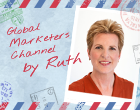マーケティングキャンパス 基礎から実践までB2Bマーケティングを学ぶサイト
ホーム > コラム > ルース教授のグローバル講座 ─Global Marketers Channel by Ruth─ > ランディングページを成功させるための7つのヒント─7 steps to a better B2B landing page─
2019.09.24

ランディングページを成功させるための7つのヒント
─7 steps to a better B2B landing page─
グローバル担当者向け
長年に渡りデジタルキャンペーンを実践していても、ランディングページを効果的に運用して機能させることは難しく、B2Bマーケターの課題となっています。ランディングページには、アウトバウンドメッセージに反応した見込み客を獲得し、関係を構築するきっかけをつくるという重要な役割があります。
今回は、ランディングページを成功させるための7つのヒントをご紹介します。
アウトバウンドメッセージからダイレクトにランディングページにアクセスできるようにすることで、クリックしたユーザにストレスのない体験をさせましょう。SEM、メール、DM、広告などのアウトバウンドメッセージには、ユーザがランディングページのURLをクリック、または入力したくなるような、ティーザーのような見せ方が必要な場合があります。ランディングページは、案件のきっかけをつくる役割もあります。見込み客を取り込むためには、ランディングページとアウトバウンドメッセージをセットで機能させることが重要です。
マーケティングキャンペーンごとに、新しいランディングページを作成しましょう。より良い効果検証のためにも、A/Bテストを実施する場合はアウトバウンドメッセージだけでなく、ランディングページも2パターン用意する必要があります。
モバイル用のランディングページを作成しましょう。タブレットやスマートフォンの利用者は劇的に増加しており、対応が必須です。
顧客が多くの情報を再入力することを避けるためにも、フォームに顧客情報が自動的に表示されるように設定しましょう。
さらに、次のステップに進んでもらうための確認や質問項目は、最小限に留めるようにしましょう。入力必須項目が多いほど、回答率が低くなる傾向があります。
定期的に検証し、改善しましょう。ランディングページを利用し、キャッチコピーやオファーメッセージ、デザイン、フォームの項目を検証し、継続的に改善することが必要です。
成功事例を参考にしながら、ランディングページをデザインしましょう。ランディングページの目的は、見込み客のアクションを引き出すことです。キャッチコピーやオファー、レイアウト、イメージなどは、この目的に合っているものでなければなりません。
ルース・スティーブンス プロフィール
アメリカのBtoBマーケティングを代表するコンサルタント
コロンビア大学客員教授。イーマーケティングストラテジー社 代表取締役。
コロンビア大学経営大学院卒業、MBA取得。タイム・ワーナー社、ジフ・デイビス社、IBM社などでマーケティングの要職を歴任。米国のBtoBマガジンで最も影響力のある100人のひとり、またリードマネジメント協会の注目すべき女性20人にも選ばれている。数多くのメディアにもブロガーとして寄稿し、B2Bマーケティングをテーマにした多くの著書がある。
Despite years of practice with digital campaigns, B2B marketers still have trouble getting their landing pages to work as hard as they could. I am not sure why, since there’s nothing more important to capturing the responses from outbound messages and kicking off a relationship with prospects. You could say it’s the landing page is where your campaign pays off. But I am still seeing obvious errors. So herewith I offer a 7-point checklist of landing page best practices.
Connect the landing page directly to the outbound message. When respondents click through to the landing page, they should experience a seamless flow from one to the other. The outbound message—whether a SEM ad, an email, a direct mail piece or even a print ad—should act like the teaser, to motivate the recipient to click or type in the landing page URL. The role of the landing page is to close on the deal, the same way a salesperson asks for the order. So the two formats should act as one, working together to move the prospect along. If they are disjointed—whether through design or copy inconsistency—the momentum is lost.
Create a fresh landing page for each variable in your campaign. I know this means more work. But the effort that goes into the outbound message should be equal or exceeded when crafting the response vehicle. If you are doing an A/B test on your creative or your offer, you need two landing pages. Plan for it.
Mobile-enable your landing page. The dramatic rise in tablet and smartphone use cannot be ignored. As any direct marketer will tell you: Don’t get in the way. If you put up any obstacles, your response rate will inevitably be lower. A landing page that is engineered for ease of use on mobile devices is no longer a nice to have; it’s a must.
Prepopulate the form where possible. If your outbound message includes digital information about the respondents, don’t make them retype their data.
Ask for the minimal amount of information you need to take the next step in the relationship. The more elements you require, the lower your response rate. So ask yourself, “How will asking for this piece of information change the way I deal with the inquiry?” If the answer is “It won’t,” then hold that query for a later stage in the relationship.
Develop a culture of constant testing. Any responsive vehicle benefits from continuous improvement. Your landing page is the perfect place to test copy, offer, layout, and other variables like the number of data elements you ask for.
Follow landing page design best practices. Hubspot offers some excellent tips in this area. Remember that the purpose of a landing page is to drive an action. So everything you do—the copy, the offer, the layout, the graphics—must focus on that end.
Ruth P. Stevens Bio
Ruth P. Stevens consults on customer acquisition and retention, teaches marketing at business schools in the U.S. and abroad, and is a guest blogger at Biznology and Target Marketing Magazine, and a contributing writer at AdAge. Crain’s BtoB magazine named Ruth one of the 100 Most Influential People in Business Marketing. Her newest book is B2B Data-Driven Marketing: Sources, Uses, Results. Ruth has held senior marketing positions at Time Warner, Ziff-Davis, and IBM and holds an MBA from Columbia University. Learn more at www.ruthstevens.com.